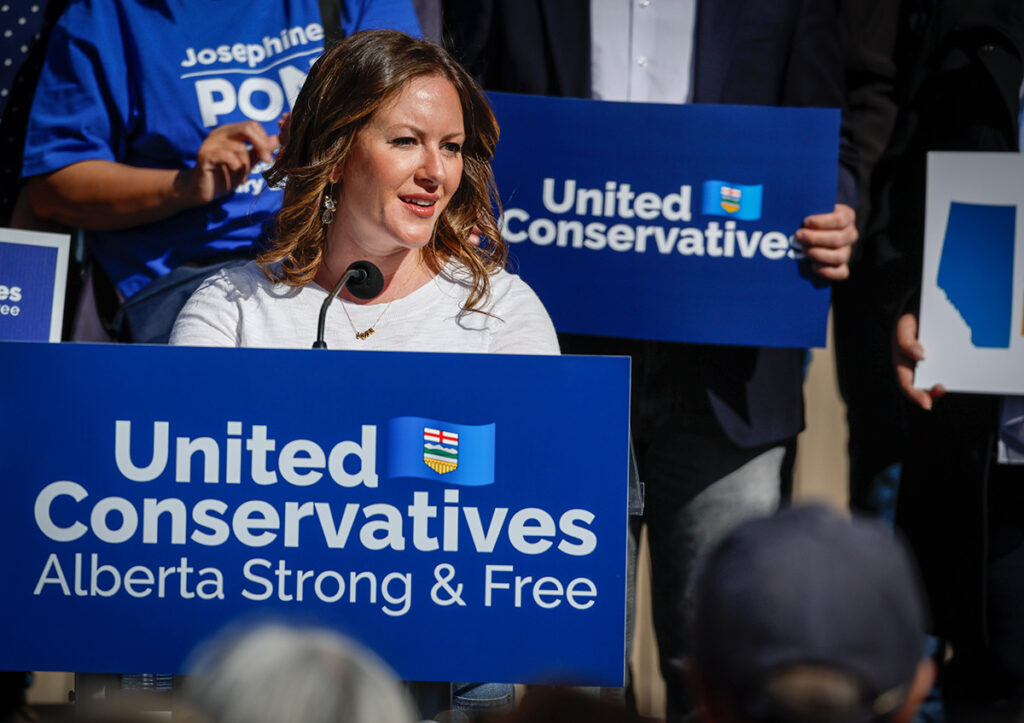
Alberta outlines five-year, $125M plan to protect communities from drought, floods
By The Canadian Press
News Emerging Trends drought flooding natural disastersApplication-based program targets communities for projects like berms and ponds.
 Rebecca Schulz speaks at a campaign launch rally in Calgary on Saturday, April 29, 2023. The Alberta government is promising to invest $125 million over the next five years to protect communities against flood and drought. THE CANADIAN PRESS/Jeff McIntosh
Rebecca Schulz speaks at a campaign launch rally in Calgary on Saturday, April 29, 2023. The Alberta government is promising to invest $125 million over the next five years to protect communities against flood and drought. THE CANADIAN PRESS/Jeff McIntosh The Alberta government is promising $125 million over five years to protect communities against flood and drought.
The money was included in last week’s provincial budget and, if approved, can be used for projects such as berms, flood walls and retention ponds.
“Due to a strong El Niño not seen in seven years, we’re seeing warmer temperatures, coupled with even less precipitation,” Environment Minister Rebecca Schulz told a news conference Monday.
“This has led to empty riverbeds and dangerously low reservoirs across our province. This is a serious situation and our government recognized we had to take immediate action.”
Schulz said the Drought and Flood Protection Program will be application-based, with municipalities, improvement districts, special areas, Métis settlements and First Nations all eligible.
At this point, she said, Alberta is preparing for the risk of a severe drought this year and wants to develop strategies and infrastructure to maximize the province’s long-term water supply.
But that doesn’t mean any specific kind of project will be prioritized.
“Right now we’re largely focused on drought here in Alberta. That’s the topic we hear most about, but again, we know that in June there is still the risk of flooding, and we saw that last year and the year before that as well. So it’s hard to say one will take precedence over the other,” Schulz said.
Additional program details, including eligibility requirements, application deadlines and cost-sharing components, will be released when the program opens later this year.
Paul McLauchlin, the president of Rural Municipalities of Alberta, said he approves.
He said rural municipalities manage more than 85 per cent of Alberta’s land mass, including areas that historically face drought and flood risks.
“Many have prioritized increased flood and drought monitoring, resilience and mitigation projects,” he said.
“Because Alberta faces a hotter and drier future with increased occurrences of major storms, provincial support for local rural resiliency projects will become a more and more important investment in protecting rural communities, residents and industries.”
The Opposition NDP’s critic for Environment and Tourism said the United Conservative Party government needs to do more, including acknowledging the role climate change plays in extreme weather.
“The UCP’s piecemeal approach to projects means smaller communities with fewer resources for pitching projects may fall through the cracks,” said Sarah Elmeligi.
“A better approach to the drought plan would be to emphasize regional co-operation, as drought issues never are limited to one community. In addition, this announcement doesn’t have a plan to enhance and expand natural wetlands, which is by far the cheapest and most effective way to mitigate drought.”
Recent drought monitoring data compiled by the City of Calgary shows little drought relief from recent heavy snowfall in the Rocky Mountains.
Mountain snowpack upstream from Calgary, which provides most of the runoff for the Bow and Elbow rivers, has increased over the last several days, but continues to trend below average.
Low river flows and dry conditions are persisting throughout southern Alberta, emphasizing the need for water conservation.
“The recent snowfall in the mountains over the last week was a welcome change, but more precipitation is needed throughout the next few months to significantly improve drought conditions,” said Nicole Newton, Calgary’s manager of natural environment and adaptation.
“If we don’t get the snow and rain we need, outdoor water restrictions will come into effect as early as this spring to ensure there’s enough water to meet Calgary’s essential needs.”
Print this page